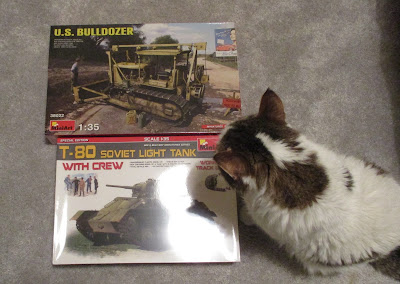A welcome trip away from WMD HQ on Monday as being of a certain age I got my Covid jab. A very slick operation by all concerned at the jab centre and my heartfelt thanks to them all.
Monday also saw the arrival of some post in the form of two MiniArt kits. I broke my New Years Resolution of no more kits but couldn't resist when an email popped up from Jadlem Models with the US bulldozer and a perusal of their site for some 1/35 Russian tankers to go with my recently finished T34 found me looking at paying about £13 or buying the T-80 light tank kit with a crew kit for £22. It was a no brainer! In effect the 1/35 MiniArt tank kit for £12! As a satisfied customer only, I will say it was good service from Jadlem - well packed and arrived in three days and no postage charge. Upon arrival at WND HQ unpacking was soon undertaken with the help of Sammy the cat who probably thought his food was in there somewhere!
Never built a MiniArt kit before but it has been started and I will update on progress and thoughts another time.
I have made progress with the narrow gauge 009 model railway. Most of the posts so far about this have been about various aspects such as baseboards, ballasting, landscaping and other such things. Today has seen a lot of progress on the scenics. Although some work has already been done a lot came together over the past few days. So here are some pictures that give a bit more of an insight into the layout. You can get a larger picture by clicking on them if you want to see more detail.
First off from the drone an aerial view showing the whole thing.
Coming under the bridge the Baldwin hauling a goods train.
A bit further round the curve the crewless Baldwin (must sort that out as it looks most odd!) heads towards the quarry.


















































